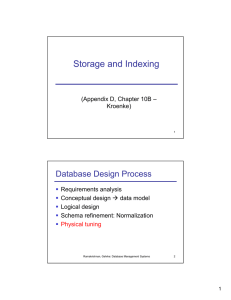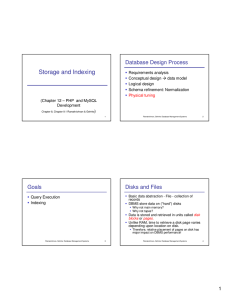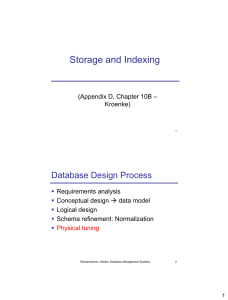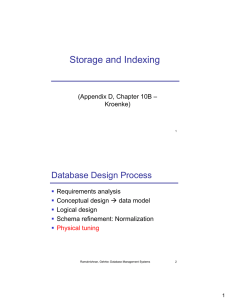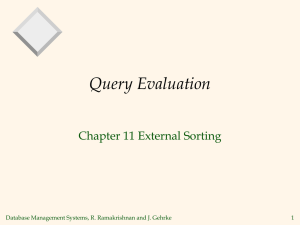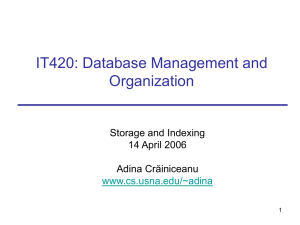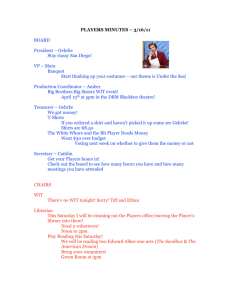Goals Disks and Files Components of a Disk IT420: Database Management and
advertisement
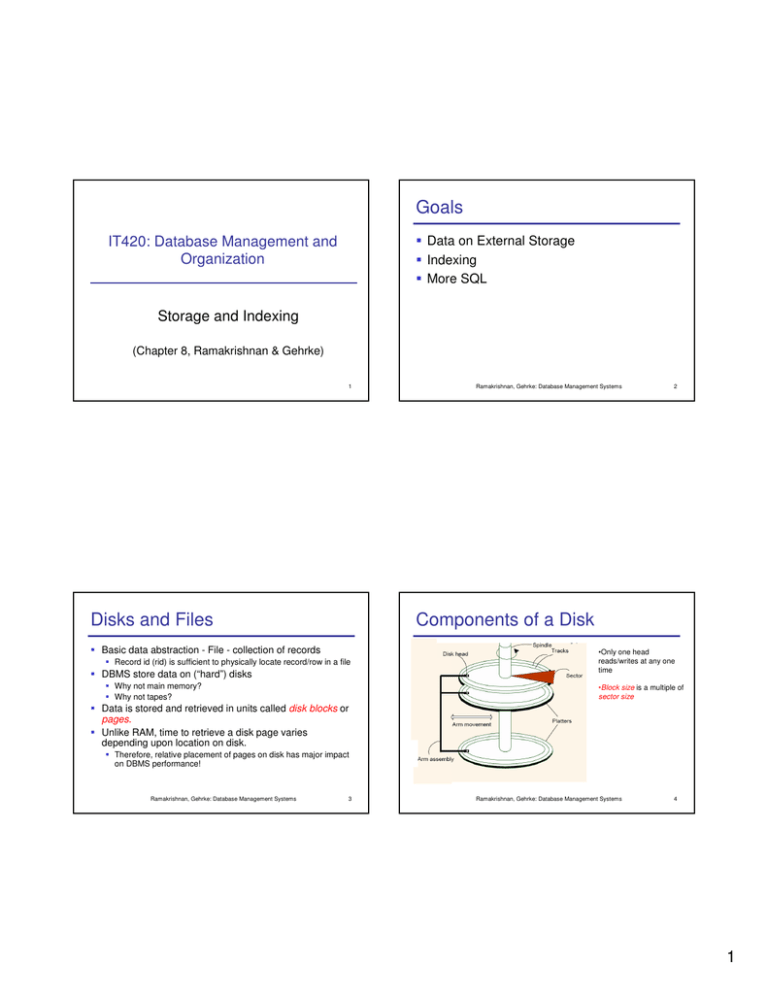
Goals IT420: Database Management and Organization Data on External Storage Indexing More SQL Storage and Indexing (Chapter 8, Ramakrishnan & Gehrke) 1 Disks and Files Ramakrishnan, Gehrke: Database Management Systems 2 Components of a Disk Basic data abstraction - File - collection of records Record id (rid) is sufficient to physically locate record/row in a file DBMS store data on (“hard”) disks Why not main memory? Why not tapes? •Only one head reads/writes at any one time •Block size is a multiple of sector size Data is stored and retrieved in units called disk blocks or pages. Unlike RAM, time to retrieve a disk page varies depending upon location on disk. Therefore, relative placement of pages on disk has major impact on DBMS performance! Ramakrishnan, Gehrke: Database Management Systems 3 Ramakrishnan, Gehrke: Database Management Systems 4 1 Accessing a Disk Page Arranging Pages on Disk Time to access (read/write) a disk block: `Next’ block concept: Seek time: 1 to 20msec Rotational delay: 0 to 10msec Transfer rate: ~ 1msec per 4KB page blocks on same track, followed by blocks on same cylinder, followed by blocks on adjacent cylinder Key to lower I/O cost: reduce seek/rotation delays! Ramakrishnan, Gehrke: Database Management Systems 5 Class Exercise Blocks in a file should be arranged sequentially on disk (by `next’), to minimize seek and rotational delay. Ramakrishnan, Gehrke: Database Management Systems 6 Class Exercise Solution Consider a disk with: average seek time of 15 milliseconds average rotational delay of 6 milliseconds transfer time of 0.5 milliseconds/page Page size = 1024 bytes Table: 200,000 rows of 100 bytes each, no row spans 2 pages Find: Number of pages needed to store the table Time to read all rows sequentially Time to read all rows in some random order Ramakrishnan, Gehrke: Database Management Systems 7 Ramakrishnan, Gehrke: Database Management Systems 8 2 Fast Queries Indexes Equality queries: SELECT * FROM Product WHERE BarCode = 10002121 Range queries: SELECT * FROM Items WHERE Price BETWEEN 5 and 15 An index on a file speeds up selections on the search key columns Any subset of the columns of a table can be the search key for an index on the table Assume: 200,000 rows in table – 20000 pages on disk Need indexes to allow fast access to data Ramakrishnan, Gehrke: Database Management Systems 9 Hash Index Ramakrishnan, Gehrke: Database Management Systems 10 B+ Tree Index Constant search time Equality queries only O(logdN) search time d – fan-out (~150) N – number of data entries Supports range queries Ramakrishnan, Gehrke: Database Management Systems 11 Ramakrishnan, Gehrke: Database Management Systems 12 3 Example B+ Tree Index Classification Clustered vs. unclustered: If order of data records is the same as order of data entries, then called clustered index. A file can be clustered on at most one search key. Cost of retrieving data records through index varies greatly based on whether index is clustered or not! Find 28*? 29*? All > 15* and < 30* Insert/delete: Find data entry in leaf, then change it. Need to adjust parent sometimes. Change sometimes bubbles up the tree Ramakrishnan, Gehrke: Database Management Systems 13 Clustered vs. Unclustered Ramakrishnan, Gehrke: Database Management Systems 14 CREATE INDEX in MySQL CREATE [UNIQUE] INDEX index_name [USING index_type] ON tbl_name (col_name,...) index_type BTREE | HASH Example: CREATE INDEX I_ItemPrice USING BTREE ON Items (Price) SELECT * FROM Items WHERE Price between 5 and 10 SELECT * FROM Items WHERE ItemID = 100111 Ramakrishnan, Gehrke: Database Management Systems 15 Ramakrishnan, Gehrke: Database Management Systems 16 4 Use Indexes – Decisions to Make Index Selection Guidelines What indexes should we create? Which tables should have indexes? What column(s) should be the search key? Should we build several indexes? For each index, what kind of an index should it be? Columns in WHERE clause are candidates for index keys. Exact match condition suggests hash index. Range query suggests tree index. Try to choose indexes that benefit as many queries as possible. At most one clustered index per table! Think of trade-offs before creating an index! Clustered? Hash/tree? Ramakrishnan, Gehrke: Database Management Systems 17 Ramakrishnan, Gehrke: Database Management Systems Examples Class Exercise B+ tree index on E.age can be used to get qualifying tuples. What index would you construct? 1. SELECT * FROM Mids WHERE Company = 6 2. SELECT CourseID, Count(*) FROM StudentsEnroll WHERE Company = 6 GROUP BY CourseID How selective is the condition? Is the index clustered? Consider the GROUP BY query. If many tuples have E.age > 10, using E.age index and sorting the retrieved tuples may be costly. Clustered E.dno index may be better! Equality queries and duplicates: Clustering on E.hobby helps! Ramakrishnan, Gehrke: Database Management Systems 19 Ramakrishnan, Gehrke: Database Management Systems 18 20 5 SQL Correlated Subqueries JOIN ON Syntax SELECT FName, LName FROM Students S WHERE EXISTS (SELECT * FROM Enroll E WHERE E.CourseID = ‘IT420’ AND E.Alpha = S.Alpha) Students(Alpha, LName, FName, Class, Age) Courses(CourseID, Description, Textbook) Enroll(Alpha, CourseID, Semester, Grade) Ramakrishnan, Gehrke: Database Management Systems Find the names of students enrolled in ‘IT420’ SELECT LName, FName FROM Students S JOIN Enroll E ON S.Alpha = E.Alpha WHERE CourseID = ‘IT420’ Find the names of students enrolled in ‘Database Management’ 21 Ramakrishnan, Gehrke: Database Management Systems Multiple JOIN ON Outer Joins Find the names of students enrolled in ‘Database Management’ Find all students and courses in which they are enrolled in ‘Spring2006’ SELECT S.Alpha, S.LName, S.FName, E.CourseID FROM Students S LEFT JOIN Enrolled E ON S.Alpha = E.Alpha WHERE E.Semester = ‘Spring2006’ SELECT LName, FName FROM Enroll E JOIN Courses C ON E.CourseID = C.CourseID JOIN Students S ON E.Alpha = S.Alpha WHERE C.Description = ‘Database Management’ Ramakrishnan, Gehrke: Database Management Systems 22 23 Ramakrishnan, Gehrke: Database Management Systems 24 6 Summary How data is stored on disk is important Indexes are used to speed up queries They can slow down insert/delete/update performance Can have several indexes on a given table, each with a different search key. Indexes can be Hash-based vs. Tree-based Clustered vs. unclustered Ramakrishnan, Gehrke: Database Management Systems 25 7
